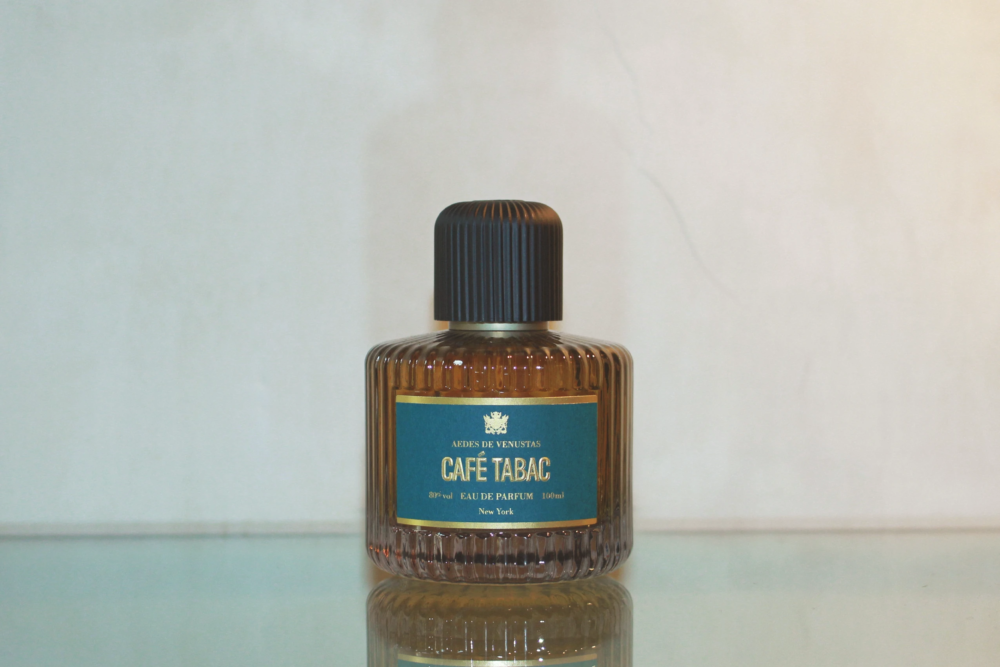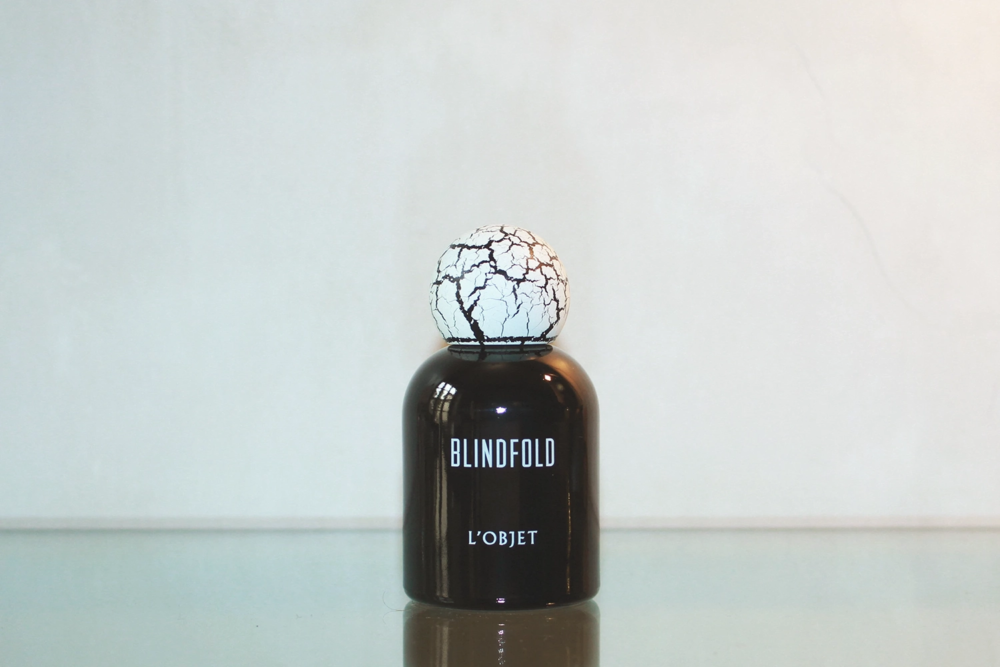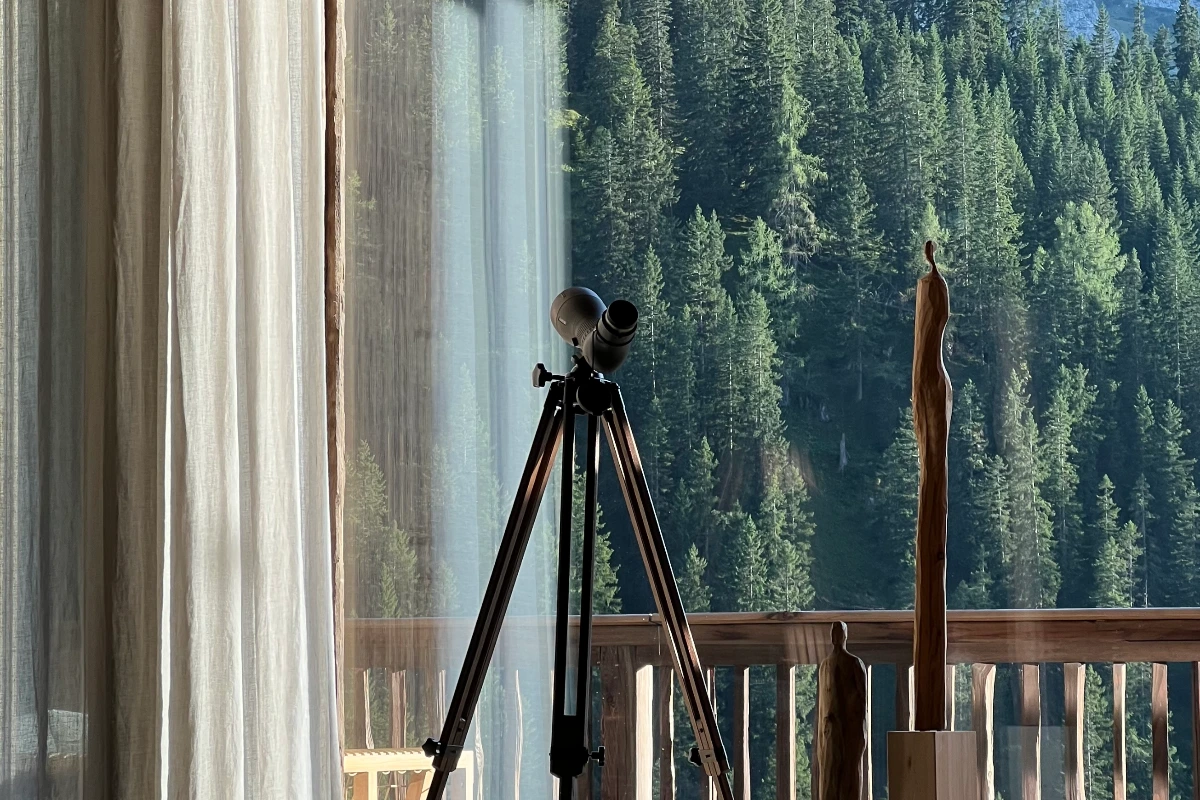
Eriro Alpine Hide: a mountain refuge for travelers drawn to meaning and beauty
At Eriro Alpine Hide, the welcome is wool socks, not passwords: a high-altitude reset where no Wi-Fi and strong materials – larch, spruce, sheep’s wool – gently push travelers back into their own senses
Where the forest begins: Eriro Alpine Hide, a sustainable alpine retreat in Tyrol
The cable car rises quietly above the village of Ehrwald, leaving roads, engines and routines behind in a matter of minutes. At around 1,550 meters, the cabins slide over a band of land where spruce forest loosens and alpine pasture begins. This is the precise point where Eriro Alpine Hide stands: a retreat built at the edge of the forest, which in local language gives the place its name – eriro.
This threshold is more than a scenic vantage point. It is a real topographical condition that shapes everything that happens here. Trails peel away toward the Wetterstein massif, the Zugspitze, the jewel-like Seebensee and the wilder Gaistal. The altitude dictates the microclimate, the availability of building materials, the cycle of water and the movements of wildlife that pass close to the buildings at dusk and dawn.
The mountain sets the rules; the project takes them seriously.
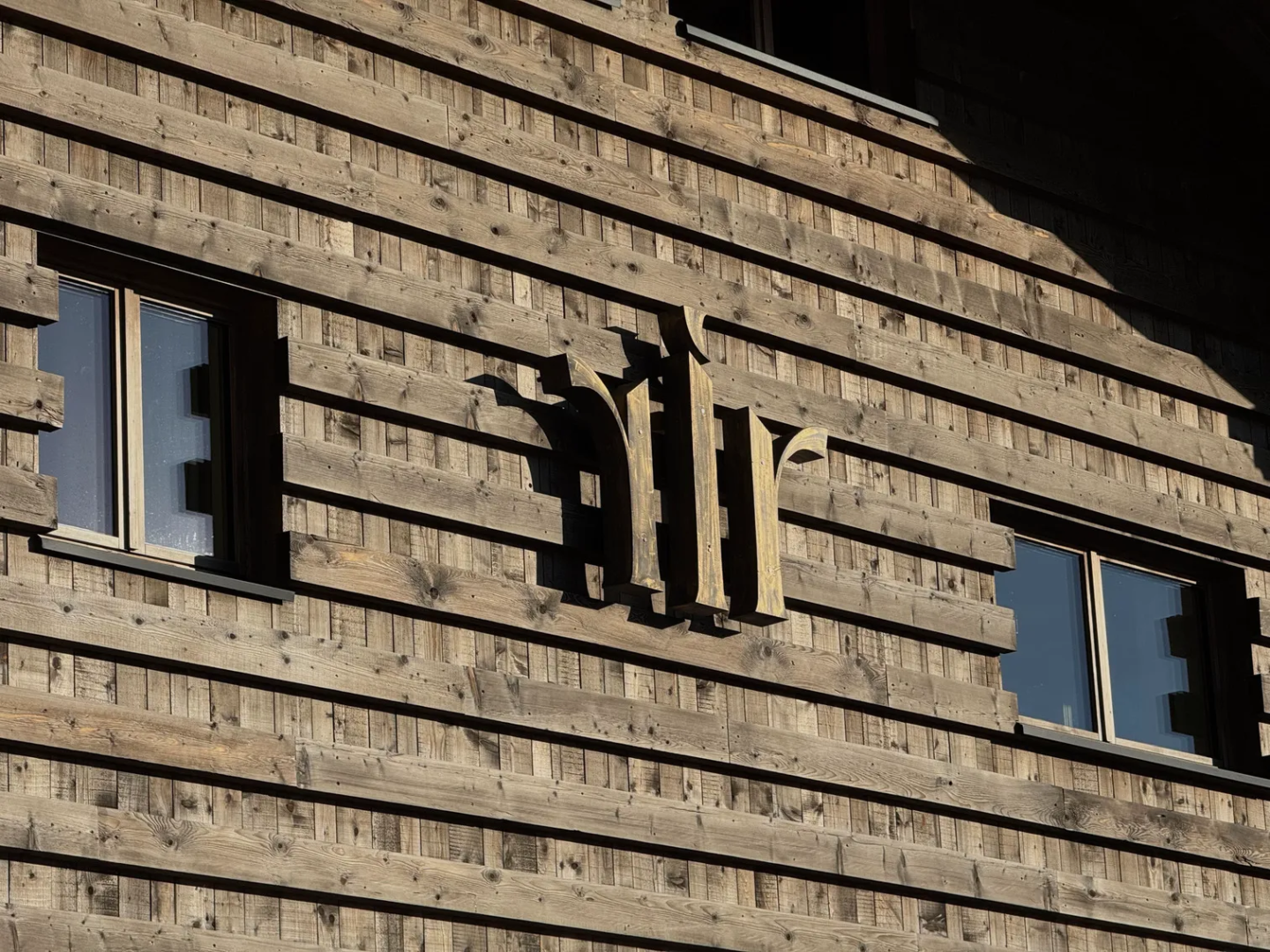
Three families and a plateau: local life shaping a new model of conscious hospitality
Eriro is the work of three families who grew up with this landscape: the Posch, the Mader and the Spielmann. Their everyday habits slowly assembled into a retreat long before an architect drew a line.
For Dominik Posch, the mountains around Ehrwald have always doubled as a mental map. Above the Inn valley, in a side valley called Issental, he has a personal ritual: climbing to a modest rise he calls his “reset spot.” From there, the valley and ridgelines rearrange themselves in a calming order. The gesture is small – walk, look, breathe – but over the years it suggested an idea: a place where guests could experience the same sense of recalibration through a simpler environment, clear air and fewer choices.
If Posch brought the impulse, carpenter Andreas Mader brought the tools. His workshop in the valley supplied much of the timber, detailing and technical knowledge for the project. The relationship runs deeper than supply contracts. The offcuts, shavings and discards of his daily work feed the wood-chip boiler that warms Eriro’s rooms, water and spa. Timber moves from forest to workshop to building to energy in a continuous loop.
The Spielmann family holds the calendar in their hands. They manage flocks and follow the strict rhythm of alpine pasture, from moving animals up to high grass in early summer to the Schafschoad, the collective autumn descent that ends the season. Their expertise in reading weather, terrain and animal behavior meant the retreat could slot into existing grazing patterns instead of pushing them aside. Eriro belongs to a valley where agriculture and tourism share the same slopes, and the balance between them depends on people like the Spielmann who live both worlds.
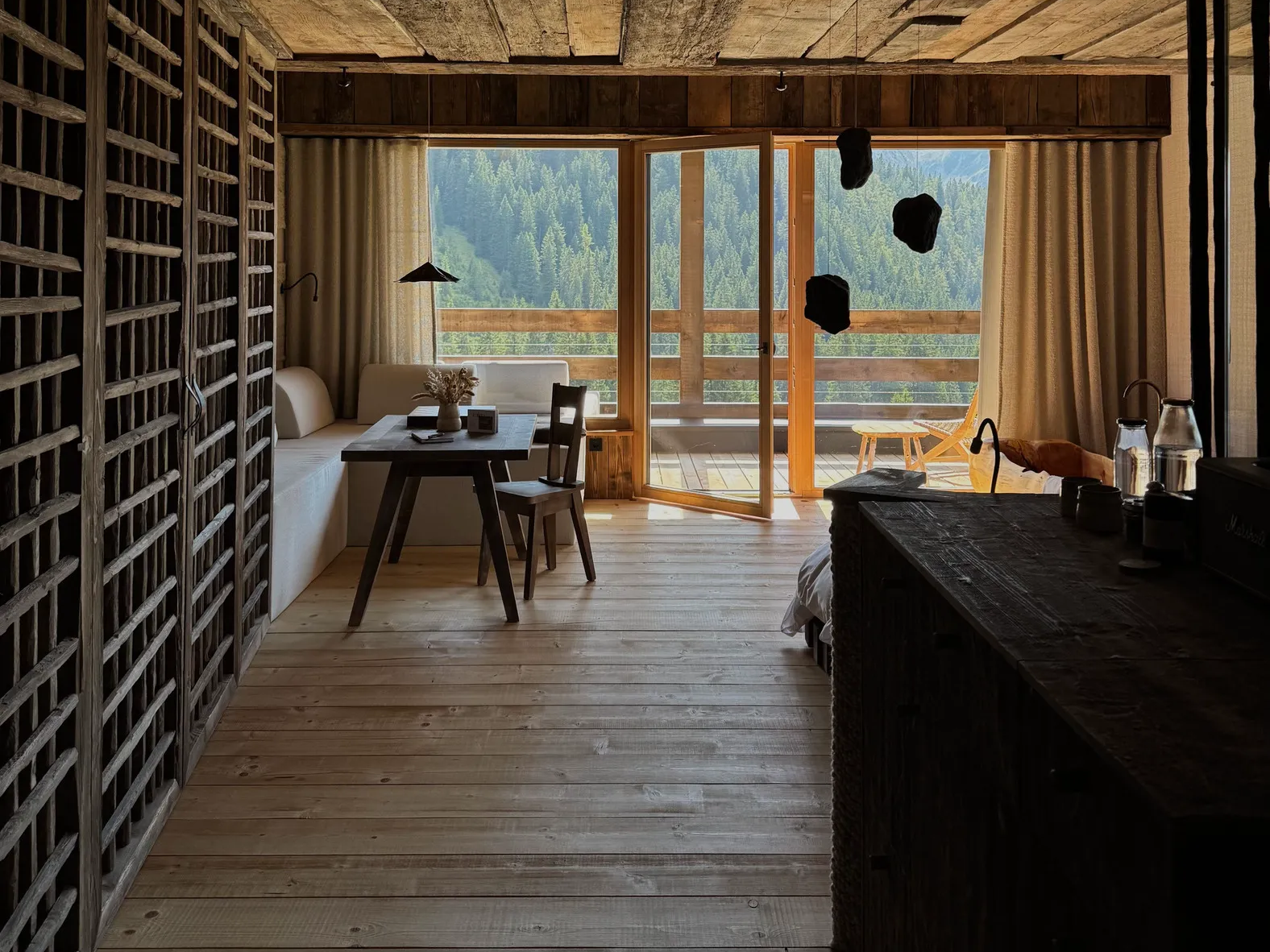
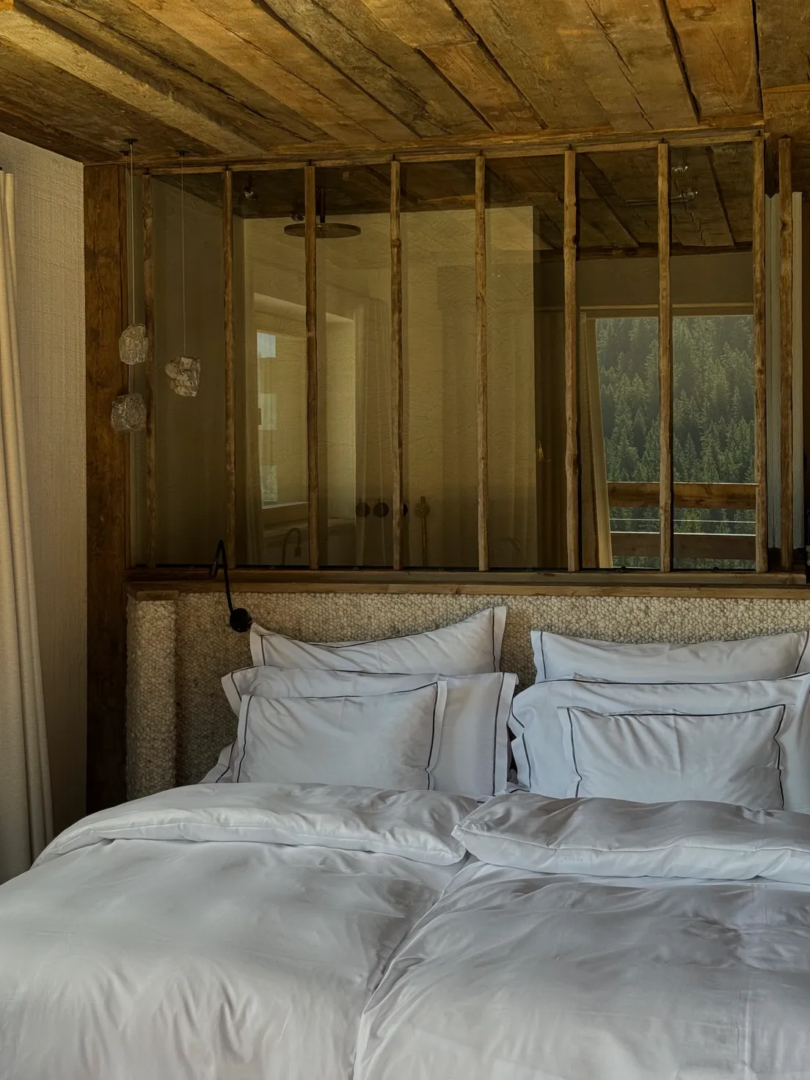
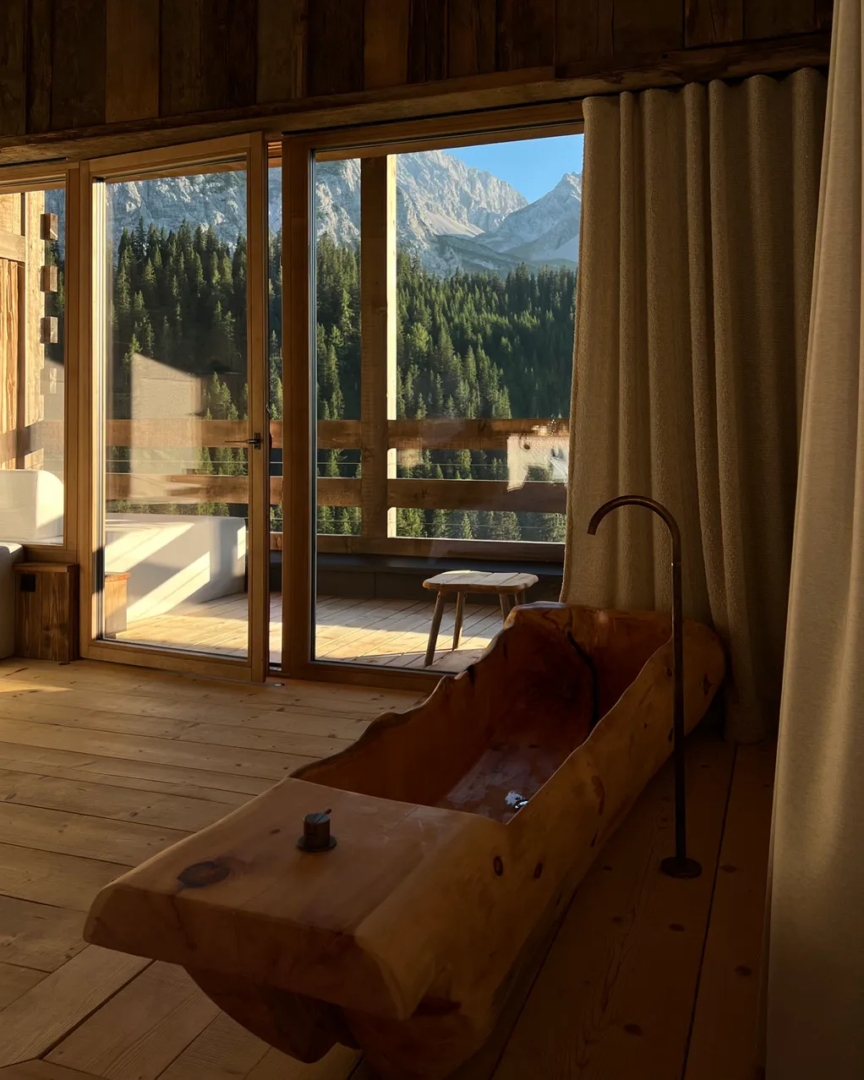
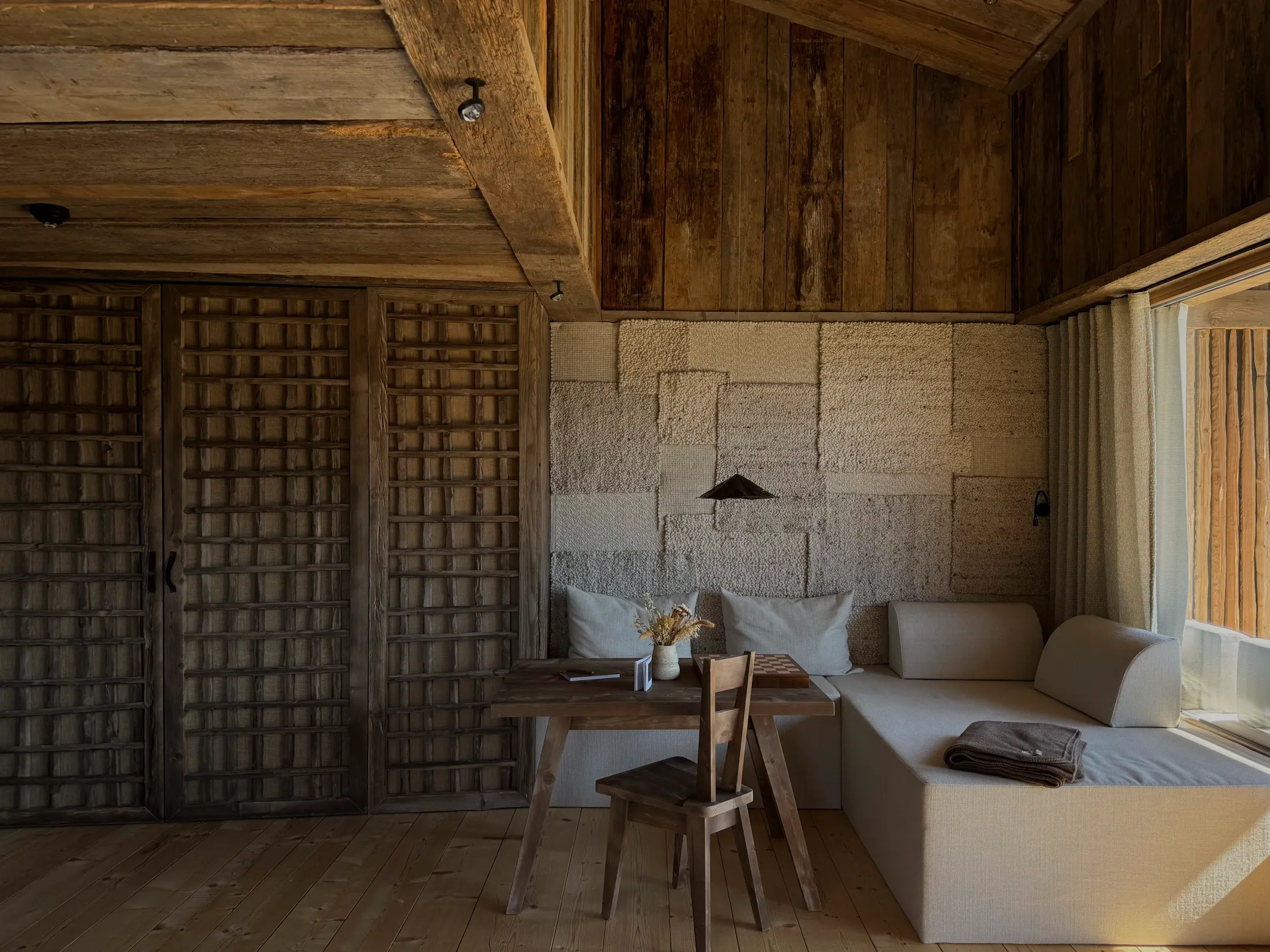

Architecture in the snow zone: alpine design with pitched roofs, larch shingles and wool insulation
Eriro’s three buildings seem almost modest. Each volume has a double-pitch roof; all sit compactly, stepping along the natural slope like a small hamlet. In a region known for photogenic glass boxes and angular showpieces, the ensemble feels remarkably quiet. The simplicity hides a highly local intelligence.
Snow on the Ehrwalder Alm does not forgive design experiments. Roof angles follow the requirements of heavy alpine winters, shedding snow efficiently and avoiding dangerous accumulations. The buildings are kept tight and solid, with carefully sized openings instead of vast expanses of glazing. The architecture engages the landscape through framed views and materials rather than through spectacular gestures.
Spruce from the surrounding forest forms the structural backbone and much of the interior cladding. This is the species that dominates the tree line around Eriro, and its use creates a direct correspondence between the forest outside and the surfaces inside. Reclaimed beams and boards, salvaged from the former inn on the site and from older rural buildings in the area, add character: different species, densities and patinas appear in the same wall or floor, creating a subtle patchwork of local history underfoot and overhead.
The roof, laid by hand in larch shingles, may be Eriro’s most distinctive architectural decision. Larch thrives in harsh alpine conditions; its wood handles rain, snow and temperature swings with ease, and can endure for decades without chemical treatment. Over time, the shingles gradually shift from warm brown to a silvery gray that echoes nearby rock faces, allowing the roof to sink visually into the mountain palette.
Inside, the retreat continues this logic of tactile coherence. Floors are solid wood. Walls are insulated with sheep’s wool washed by hand, sourced from flocks that graze the slopes around Eriro each summer. The wool moderates humidity, absorbs sound and stabilizes temperatures, so that comfort comes as much from the construction as from the heating system. Linen fabrics lend a dry, durable hand to bedcovers and upholstery. In some places, local stone adds thermal mass and a feeling of anchoring in the ground beneath the buildings.
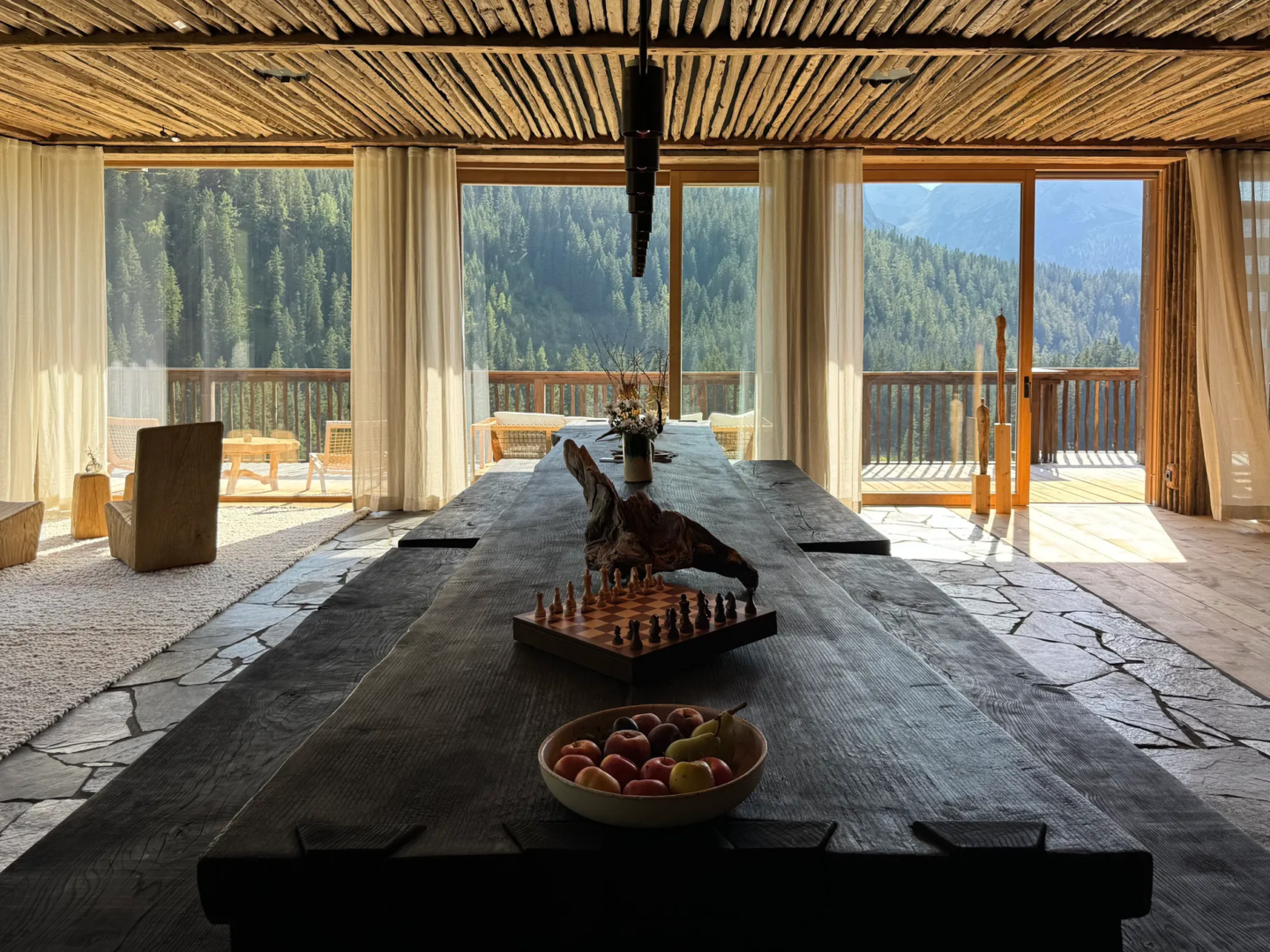
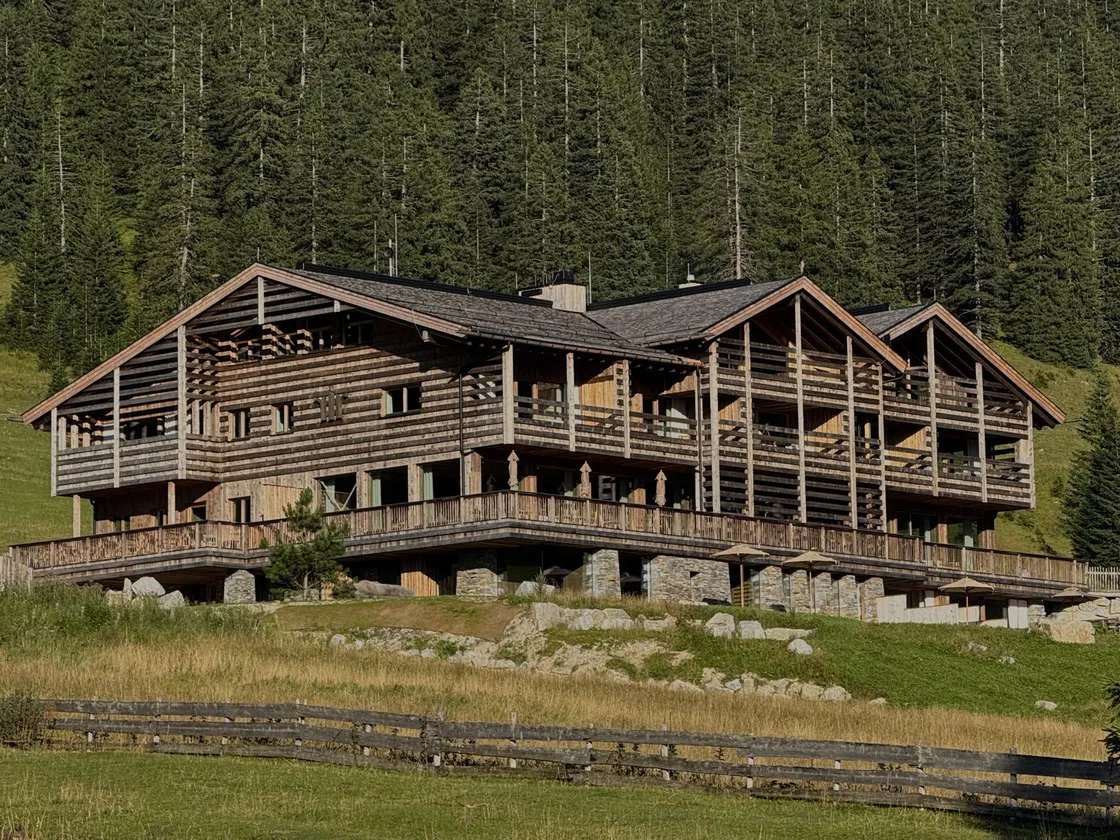
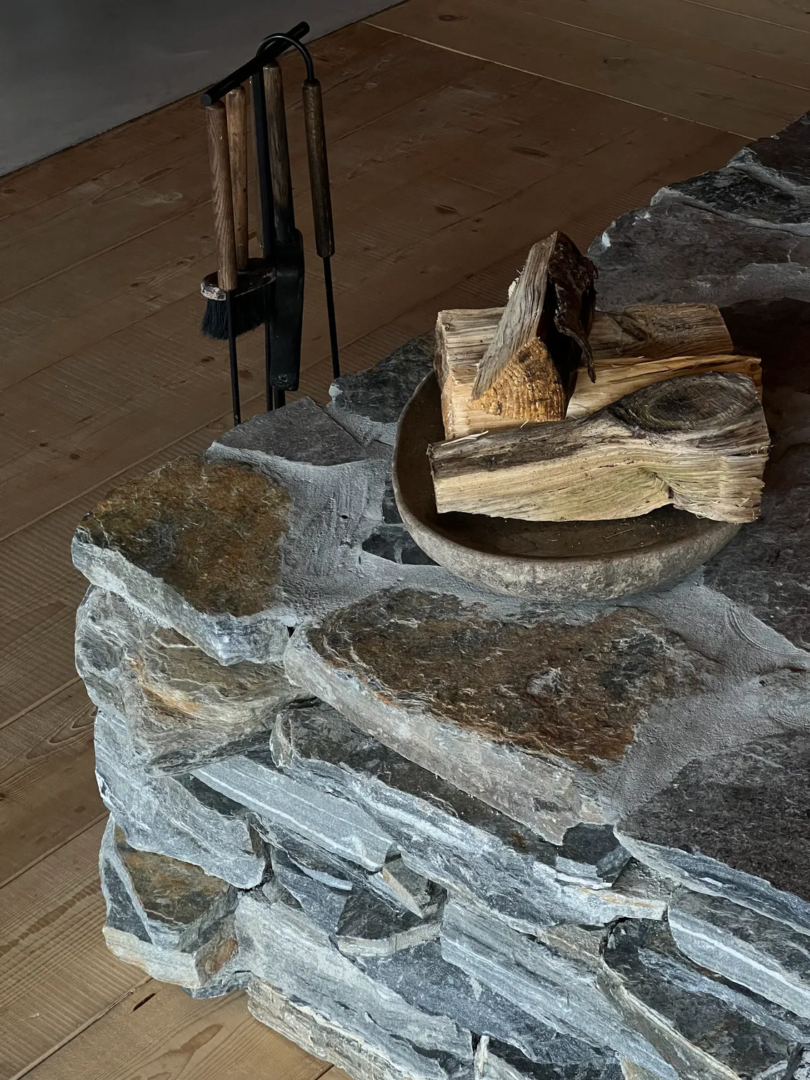
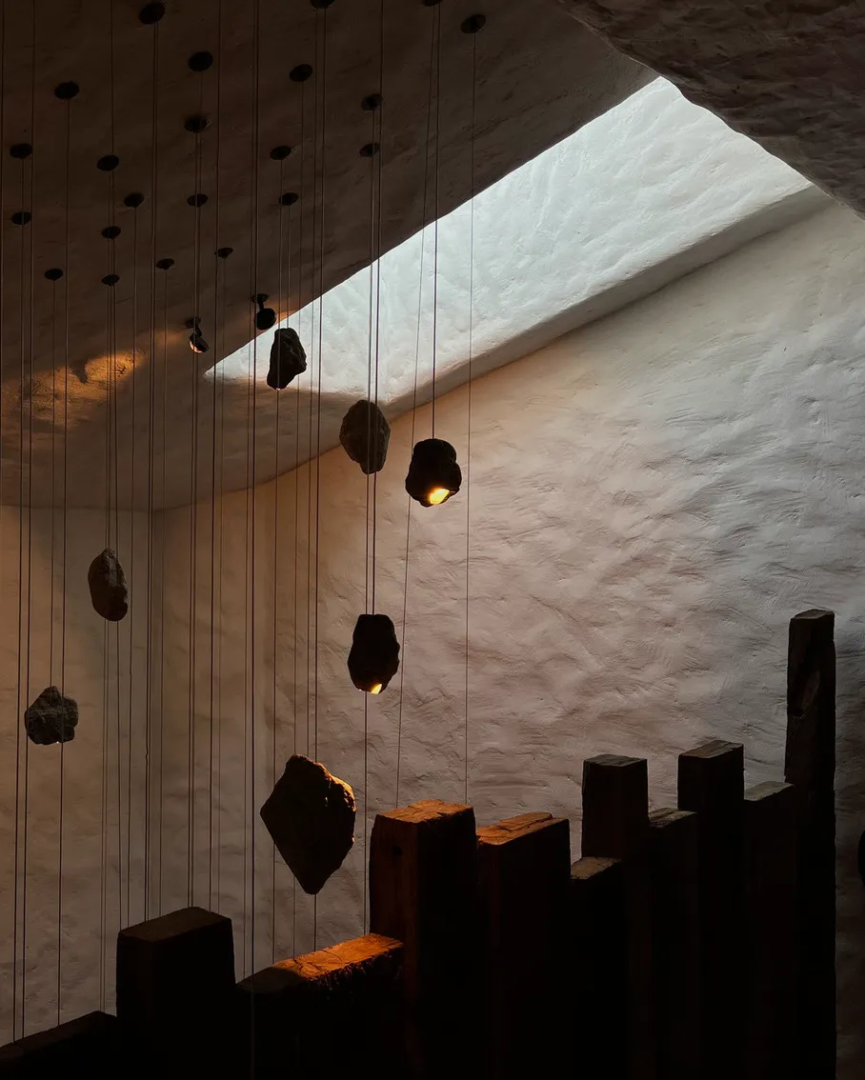
Water, woodchips and dark skies: circular energy and low-impact luxury in the high Alps
High above the valley, water becomes a protagonist. A private mountain spring lies just above Eriro, feeding the retreat through a short, direct system. The water is collected, mechanically filtered and brought to taps and showers without chemical treatment or long-distance travel. Guests drink what the mountain offers almost at the point where it surfaces. Bottled water loses its appeal when the glass in your hand holds something this immediate.
The spa follows the same line of thinking. Instead of elaborate hydraulic theater, its layout and facilities revolve around the availability and quality of this spring. The atmosphere is calm, elemental: wood, warm stone, water moving between hot and cold. It reads less like a theme park and more like a small, precise extension of the mountain’s own hydrology.
Energy, too, tells a circular story. Eriro runs on a wood-chip boiler fed by waste from Mader’s carpentry. Offcuts, shavings and unusable scraps are chipped and stored, then burned in a system dimensioned for the retreat’s needs. The same material that shapes the structure reappears as heat for rooms, water and spa. A heat-recovery unit fine-tunes efficiency, an important detail in a place where long winters and biting winds turn miscalculations into discomfort.
Once night falls, another decision becomes visible – or, more accurately, invisible. Exterior lighting is deliberately limited. Fixtures are placed low and shielded, guiding guests safely between buildings while leaving most of the plateau in darkness. The sky remains sharp, the Milky Way easily visible when weather allows, and the movement of animals continues along habitual routes. In an age of excess illumination, the experience of a genuinely dark night takes on its own quiet glamour.
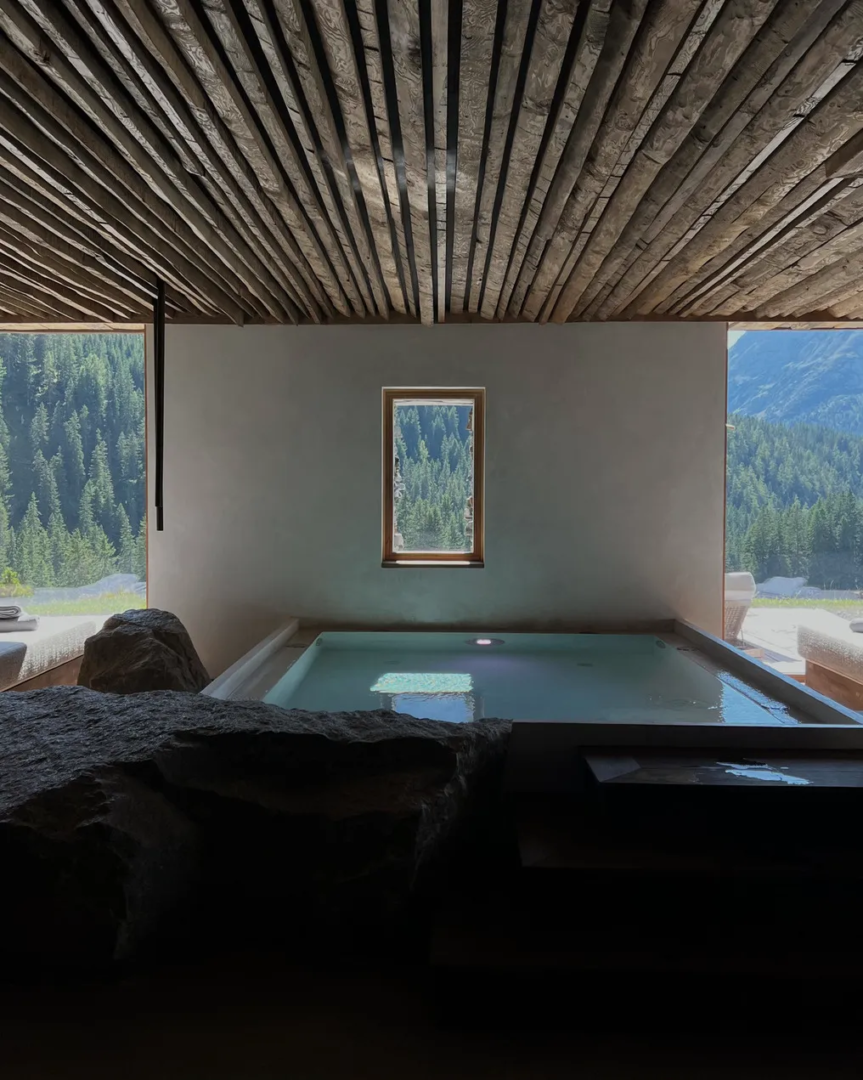
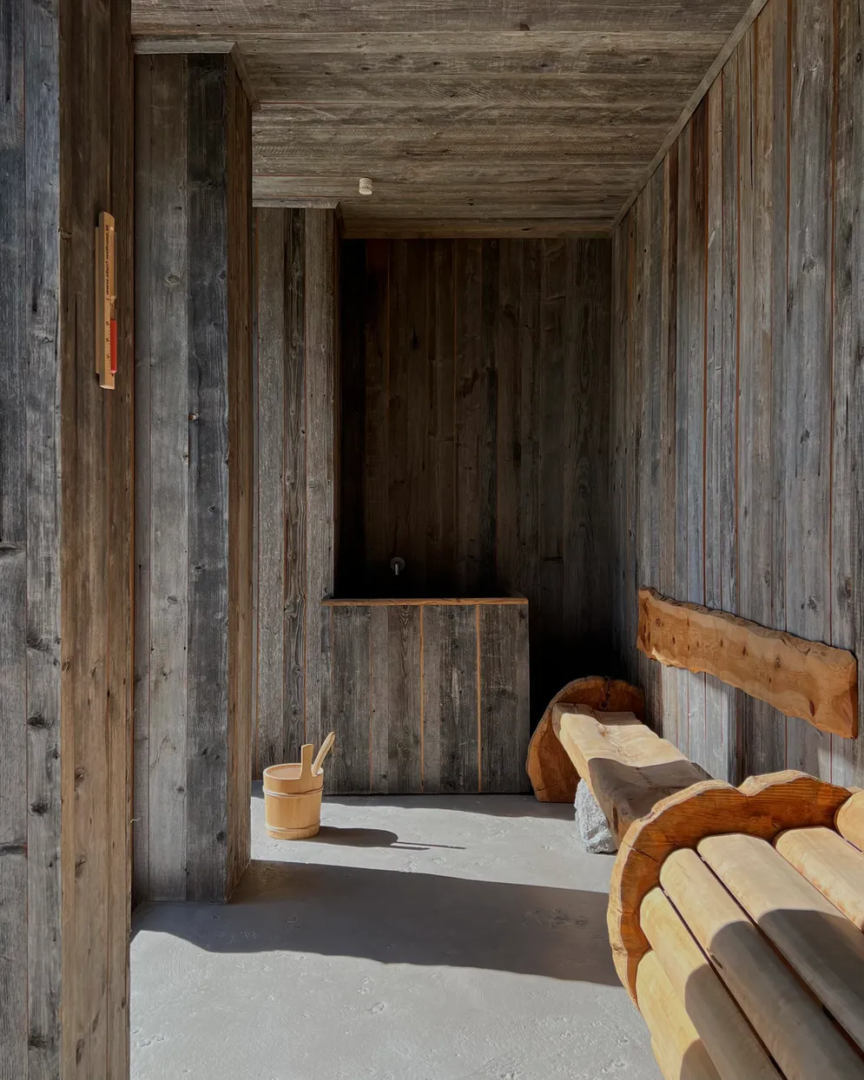
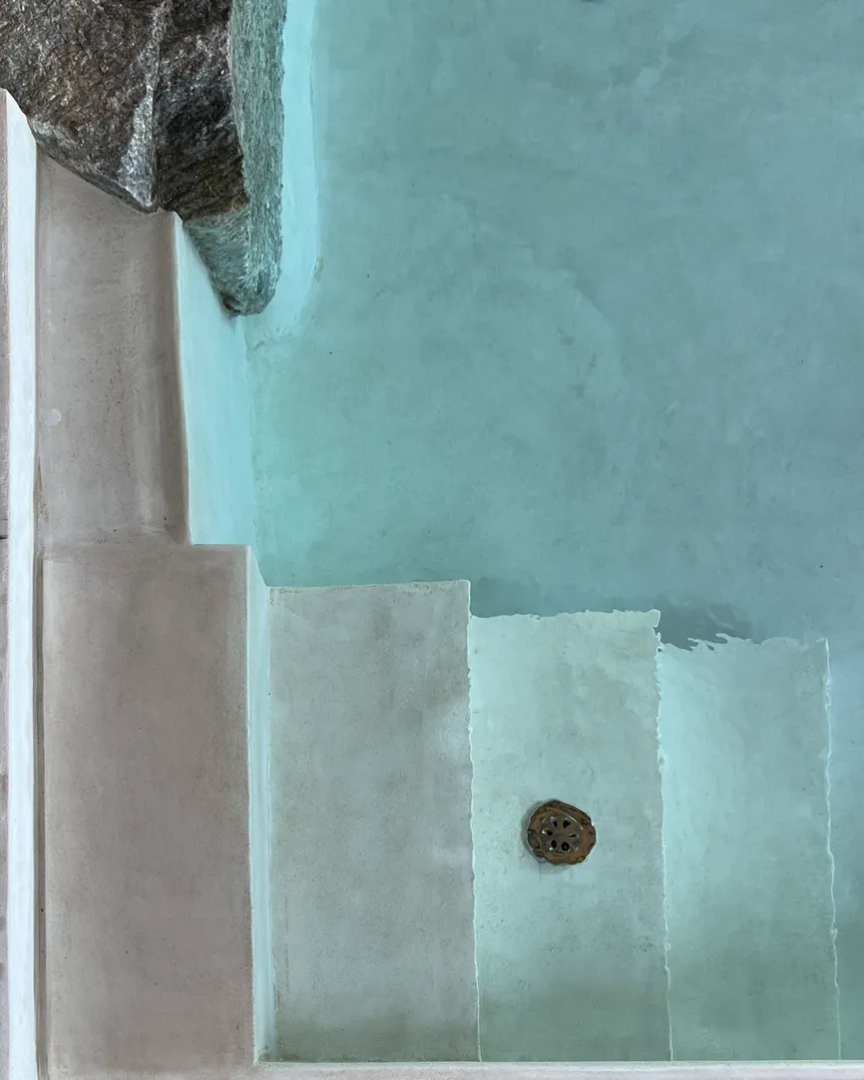
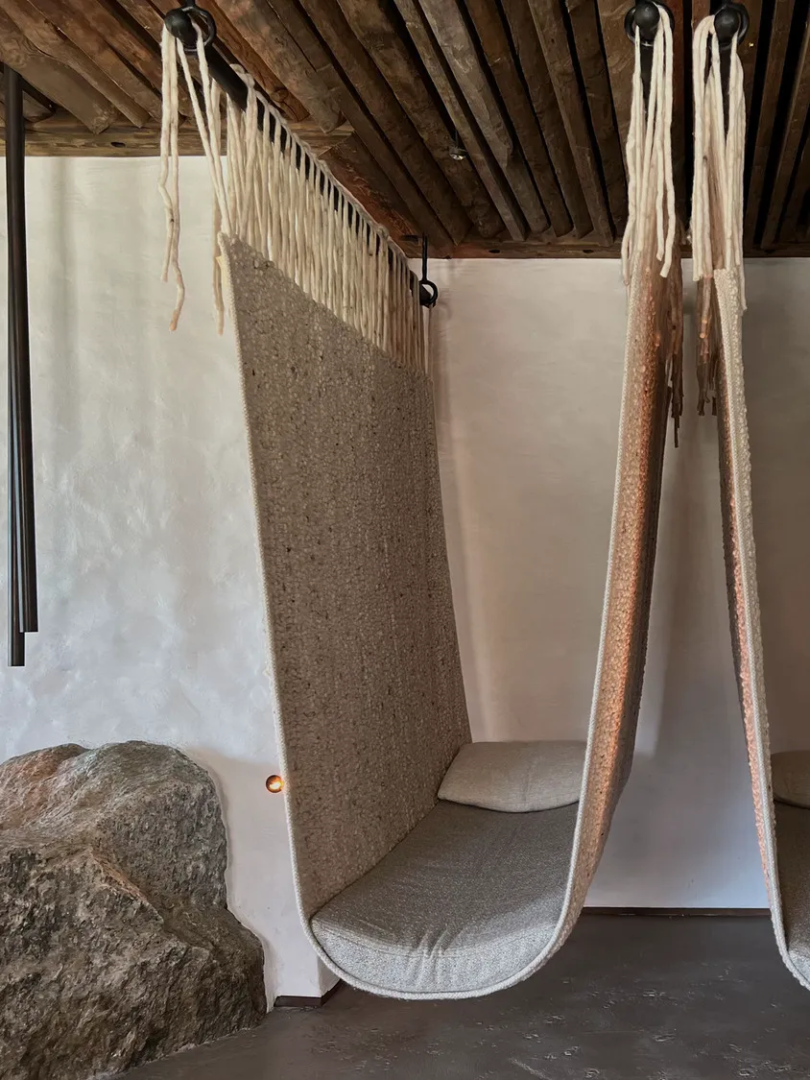
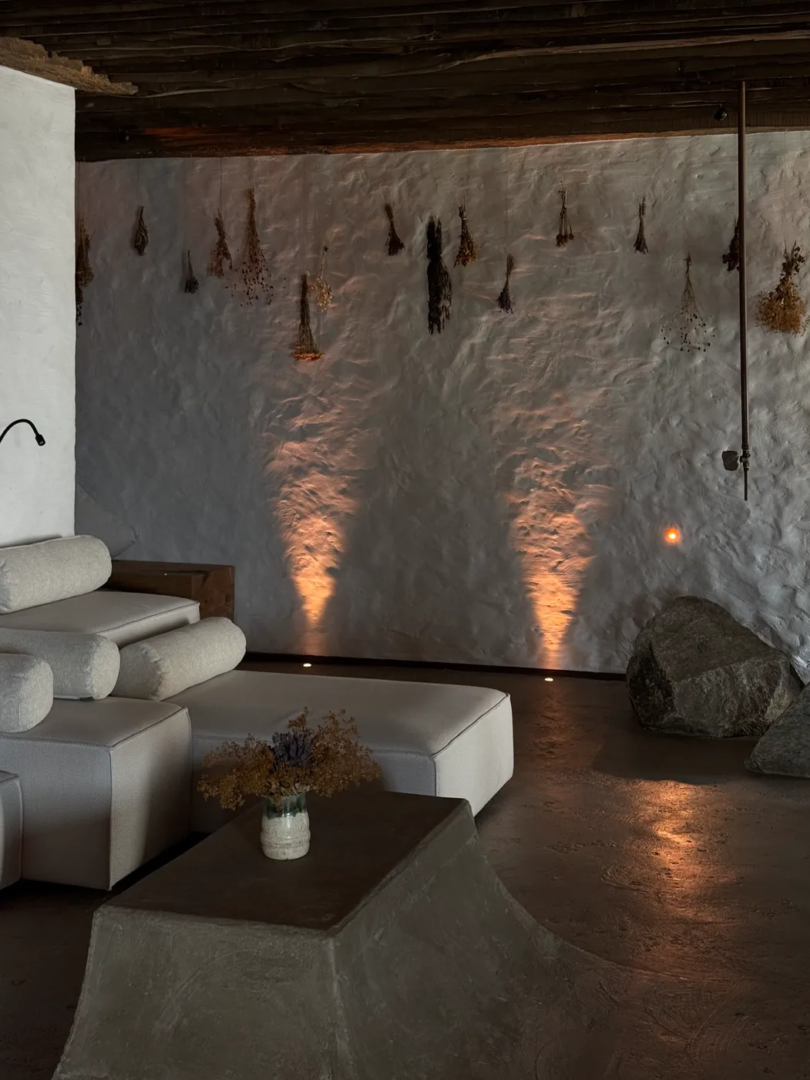
From plateau to plate: farm-to-table cuisine, foraging and mountain dining at Eriro
If the cable car governs the logistics of Eriro’s construction and maintenance, it shapes the kitchen even more. Deliveries arrive at fixed times and in finite quantities. There is no space, literal or metaphorical, for constant imports or fragile ingredients that demand daily air-freighting. Instead of fighting this constraint, the culinary team treats it as a source of identity.
The menu grows out of a small constellation of nearby farms. Biohof Lumperer supplies vegetables and many of the valley’s traditional crops, cultivated with organic methods that retain deep ties to older forms of agriculture. Biezu Hofladen provides eggs and several fresh staples. Mushrooms arrive from Schwammerlhof and from discreet foraging trips into the woods around the retreat.
Foraging on this plateau belongs to a long local tradition. Herbalists navigate a mosaic of micro-habitats: humid pockets in scree fields, thin soil at the forest edge, small clearings and streambanks where medicinal and aromatic plants concentrate. Each herb demands careful recognition, and the rules are strict. Only species that can be identified confidently are gathered. Quantities remain small and intentional. Fresh plants are wrapped in damp cotton or carried in breathable bags to preserve moisture and fragrance.
The environment imposes a form of selection. Many alpine species contain dense reserves of essential oils, tannins and active compounds that helped communities treat injuries and illness long before pharmacies. Eriro’s kitchen translates this knowledge onto plates and into cups, weaving roots, berries and leaves into broths, infusions and dishes with a light hand.
Preservation techniques extend the reach of these flavors beyond the short summer season. Fermentation, drying and other methods make it possible to serve certain herbs and roots well into the colder months. Kitchen waste is carefully minimized; trimmings and leftovers feed compost that returns nutrients to nearby plots. The result is a gastronomic system that feels tightly tuned to the valley – the opposite of a menu that could belong to any mountain hotel anywhere.

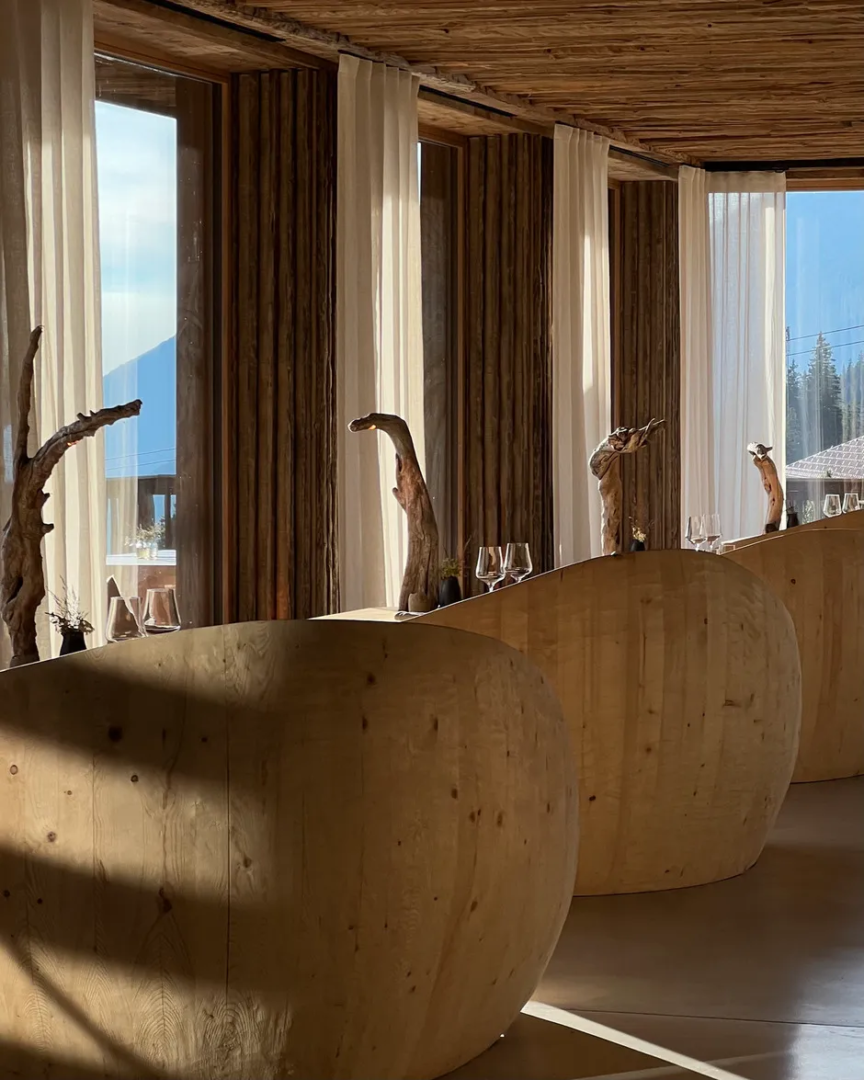
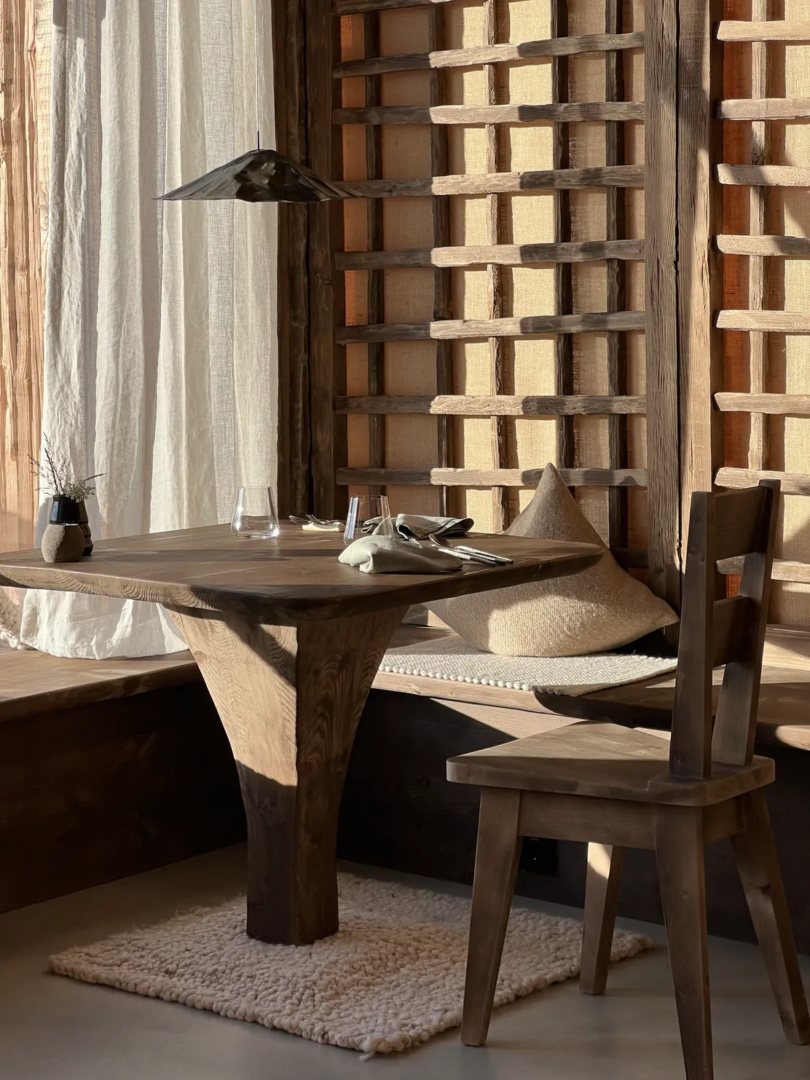
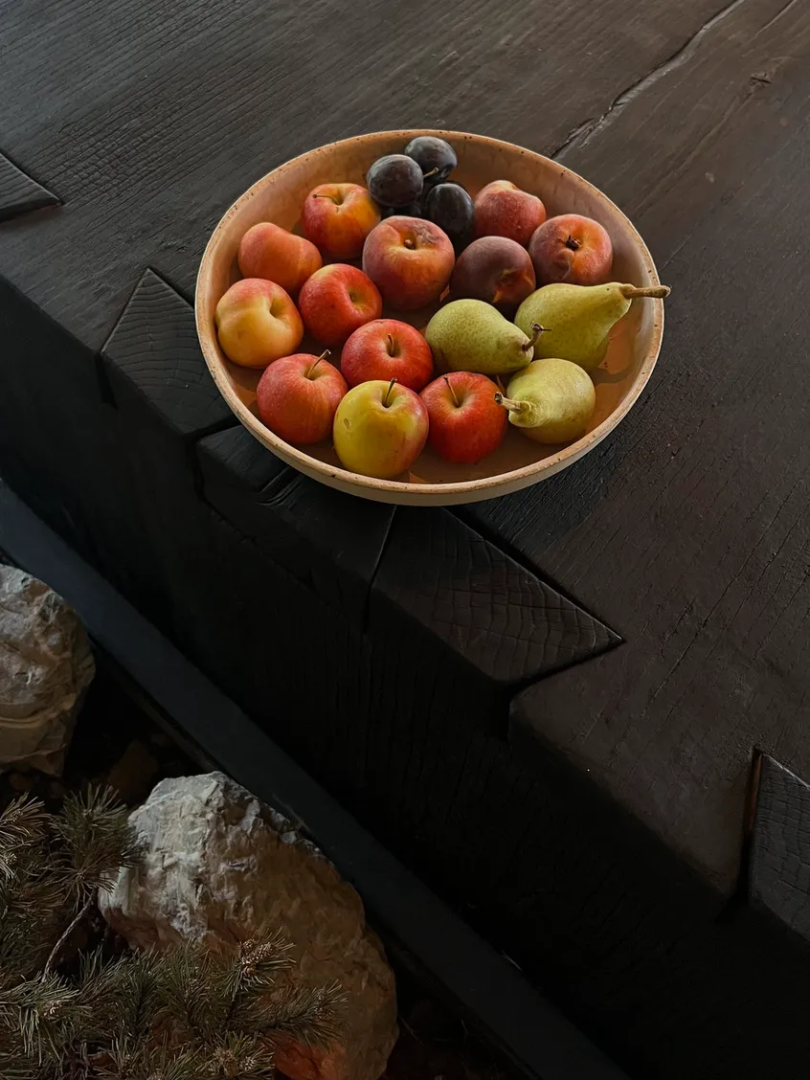
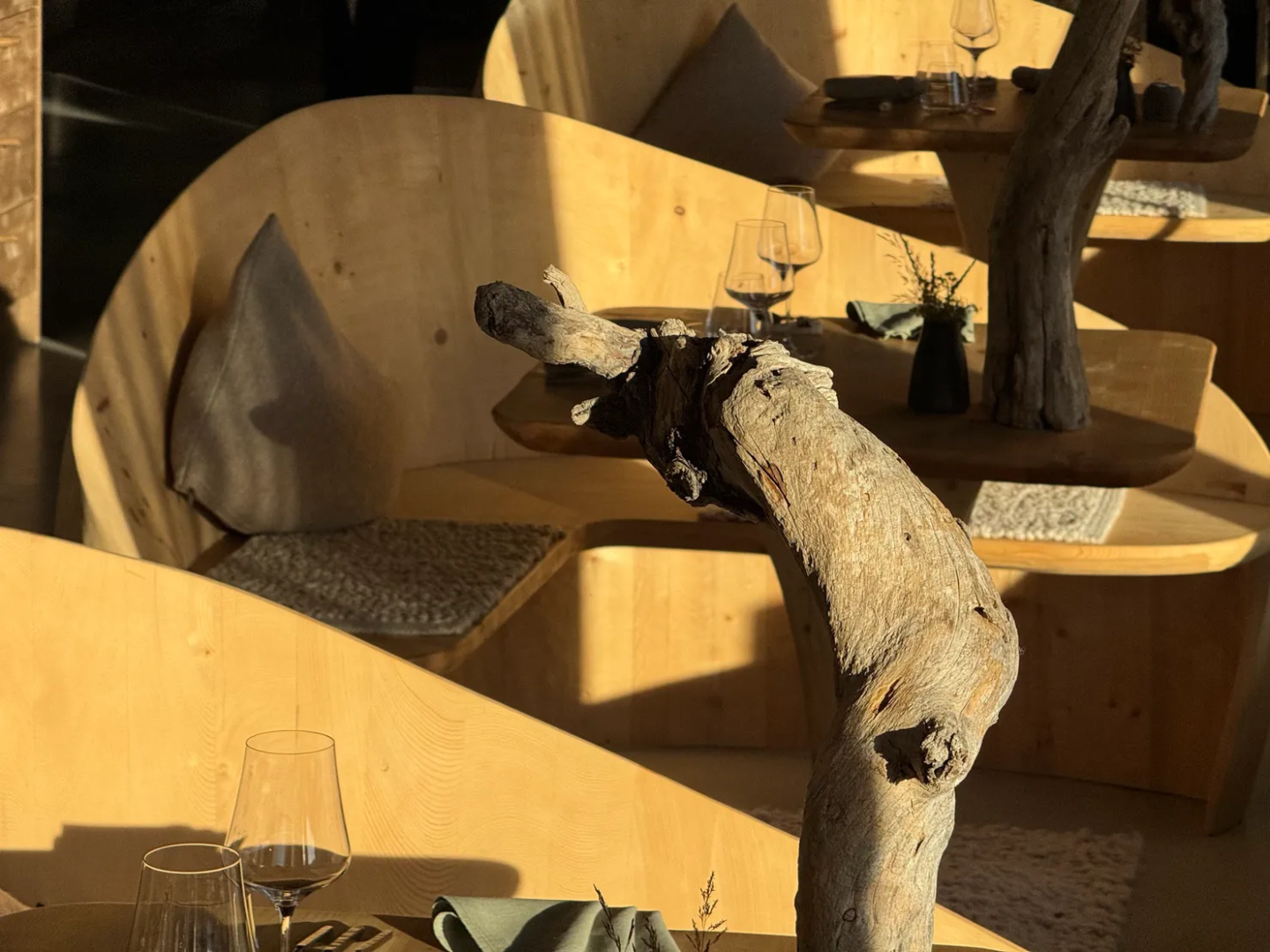
A living map around the retreat: alpine hiking trails, clearings, lakes and old miners’ paths
Step out of Eriro and the plateau unfolds as a network of places, each with a distinct role in the seasonal life of the mountain. Guests who lace up boots and start walking enter a kind of open-air atlas.
To one side lies Holzerwies, a sunlit clearing under the Wetterstein. The path reaches it almost shyly, threading through the forest before the trees fall away. In summer, the meadow buzzes with insects, and the noise of the world is reduced to wind and the distant clinking of animal bells. Locals use Holzerwies as a place to linger between chores and hikes, to sit down, stretch out and do very little.
Higher up, the Breitenkopfhütte wears the story of another economy on its timber frame. Built as a refuge for miners working these slopes, it sits under a rock wall reached by threads of trail that weave through gullies and across stone. Some segments are marked, others ask for attention and mountain experience. The hut embodies the valley’s mining history in a way that guidebooks rarely manage: steep, stony, slightly exhausting.
To the east, the Seebensee appears with a turquoise surface so vivid it often dominates social media feeds in high season. Midday brings hikers and day visitors, yet early mornings and late evenings transform the scene. The lake quiets, the reflection of the Wetterstein’s vertical faces stretches and distorts with every ripple, and the landscape feels once again like a shared space between humans and the rest of the ecosystem.
Above it, Drachensee – “Dragon Lake” – rests in a harsher cirque. The slopes around it carry more rock than grass. Vegetation clings to cracks and ledges in the form of moss cushions and tough alpine plants. The atmosphere is raw and solitary. For guests willing to climb a little higher, it offers a taste of the high mountains’ more ascetic side.
Further along, the Gaistal valley slices deep into the landscape, its rock walls, cold torrent and layered forest forming one of the area’s most intact ecological systems. For many locals, including the Eriro families, Gaistal distills everything that matters here: clean air, living water, solitude and a direct link to grazing traditions that still shape the valley’s rhythm.
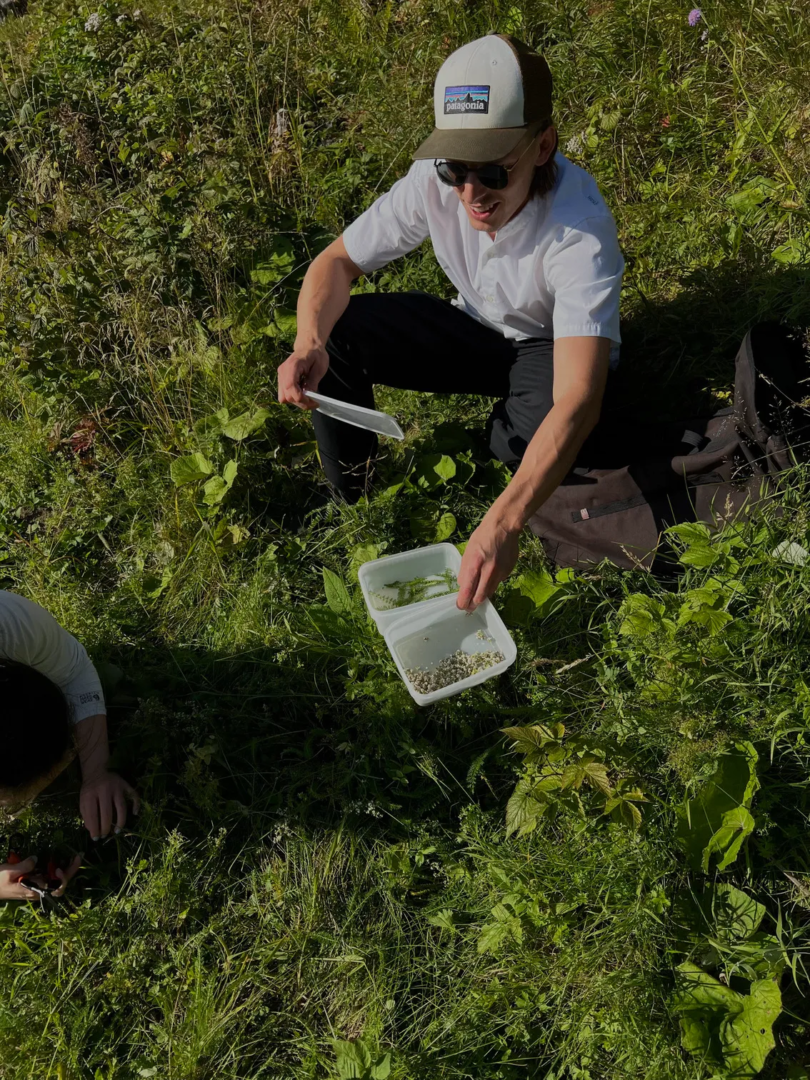
Flora, fauna and rituals: alpine biodiversity and living traditions through the seasons
The flora around Eriro reads like a catalogue of adaptation. Species arrange themselves according to altitude, sun exposure and soil depth. Many alpine plants endure long snow cover, permanent wind and sudden temperature swings. Their survival strategies – tiny leaves, deep roots, concentrated chemical defenses – make them unexpectedly potent as medicinal and culinary ingredients.
Gathering these plants requires more than an app and a basket. Local practice relies on a combination of visual recognition, touch and smell. The safest rule is disarmingly simple: pick only what you truly know. Harvests stay modest and precise, and plants travel down the slope in paper bags or wrapped in damp cloth, protected from both crushing and desiccation.
The animals that cross the plateau weave their own schedule into this botanical one. Chamois and roe deer trace lines over the slopes at dawn and dusk. Marmots claim their burrows in meadows and clearings. Birds of prey draw invisible paths in the sky that repeat from day to day. Eriro’s guest guidelines are clear: keep distance, keep quiet, leave no food or trash outside. Wildlife remains a presence rather than a performance.
Human rituals carry the same sense of continuity. In June, around the summer solstice, volunteers spend weeks hauling wood and other materials up steep slopes to prepare the Bergfeuer – mountain fires whose glowing figures flicker across ridges after dark. These fires were recognized in 2010 by UNESCO as intangible cultural heritage, but the event still feels resolutely local. The designs appear only when they ignite, visible to the valley below for a few hours before returning to darkness and ash.
Other fires, the Herz-Jesu-Feuer, burn in different parts of Tyrol on different dates, linking Christian devotion with older mountain symbols. Together, these illuminated nights give the region a shared visual language of light and belonging.
Winter brings carnival, and with it the Einscheller and Schnöller. The first move through streets with heavy bells tied around their bodies, echoing the world of herders and high pastures. The second crack whips in rhythmic patterns that reverberate off house walls and church towers. Both are meant to drive out winter’s last ghosts. The masks are characters in their own right: carved from wood by local artisans over months, they depict witches, forest spirits, human–animal hybrids and figures from valley folklore.
When summer draws to a close, the Schafschoad gathers people and animals together again. Flocks that have grazed across wide slopes are guided back down to the valley, counted, separated by owner and shorn. The wool enters various channels, including Eriro’s, where part of it returns as insulation in walls. The descent doubles as a community celebration, with food, music and the sense that another successful season has concluded.
Threaded among these real events is the recurring legend of a village sunk beneath a nearby lake. In the story, a traveler came seeking help and met only indifference. The village disappeared under water; a dragon took up guard; bells ring from the depths only on Christmas night. Tellers and listeners both know the tale belongs to myth, yet it continues to shape how people feel about water, justice and hospitality in this particular place.
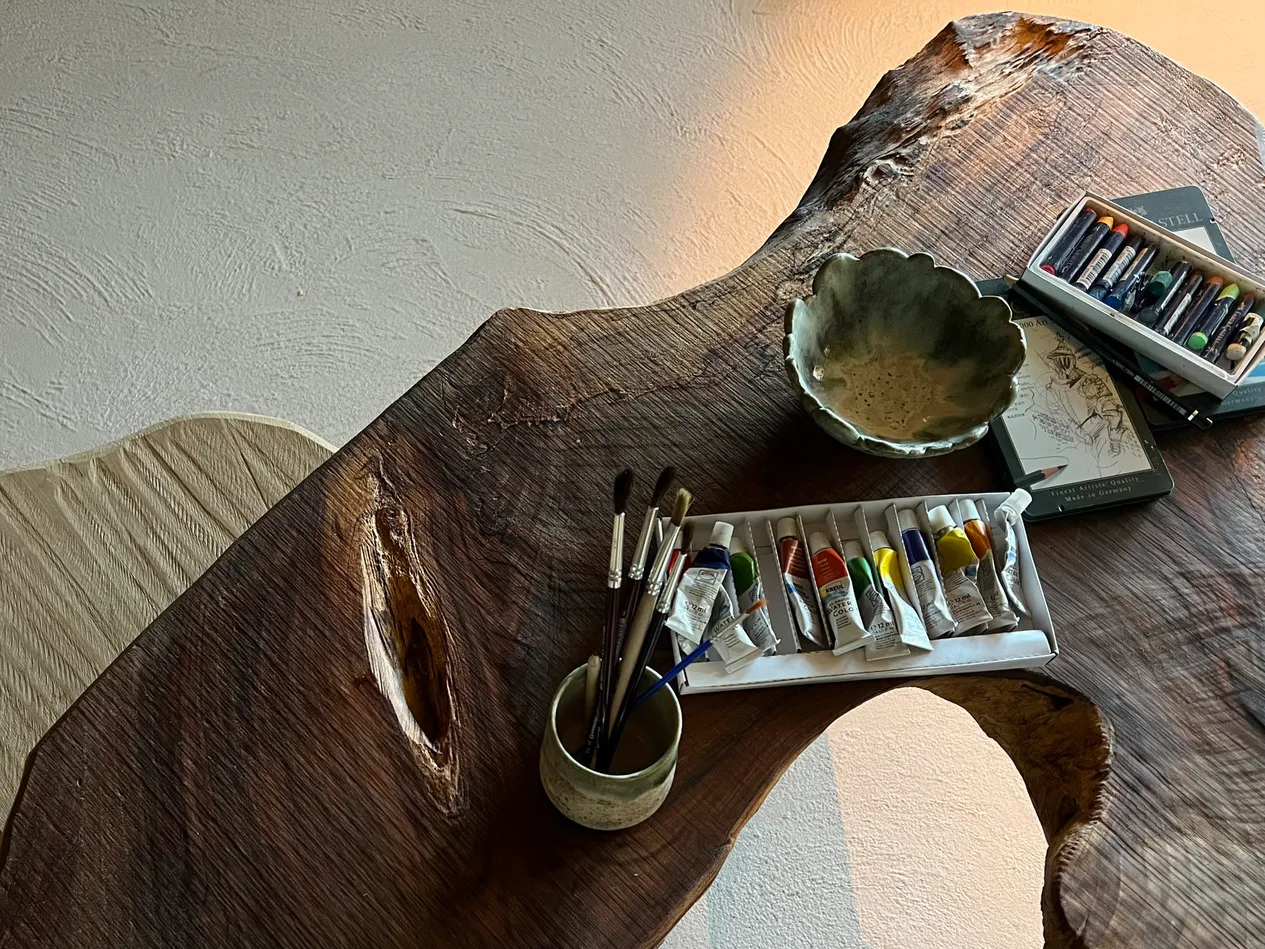
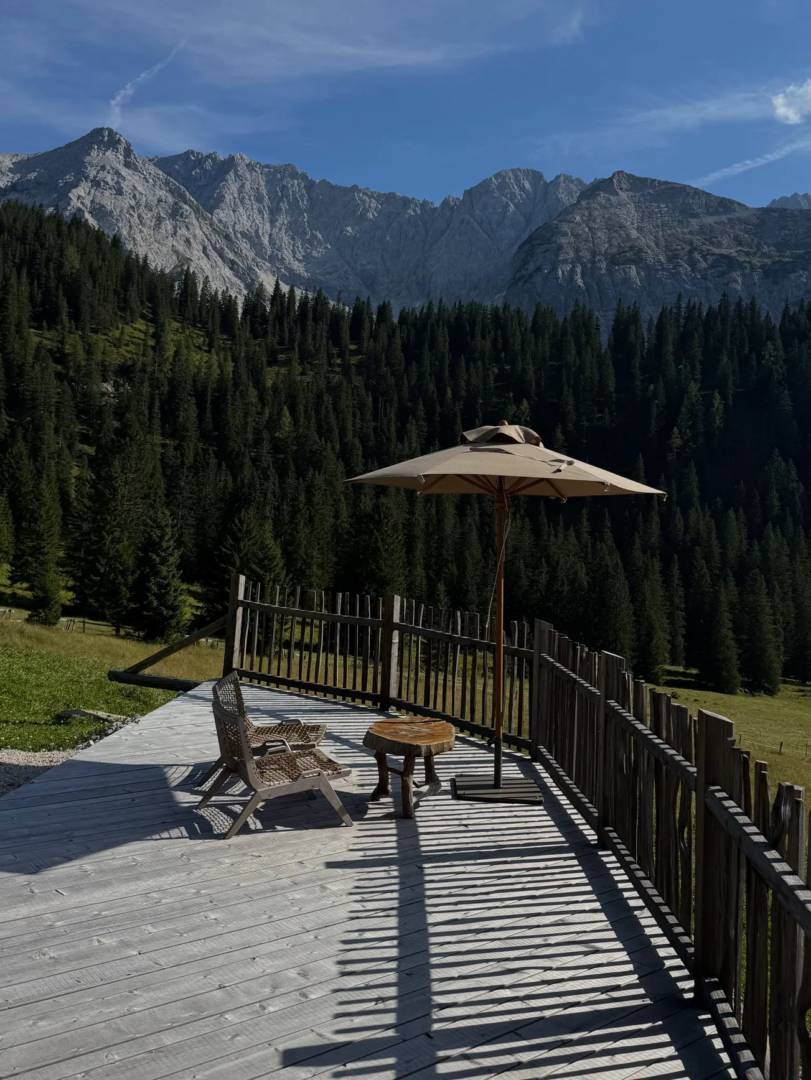
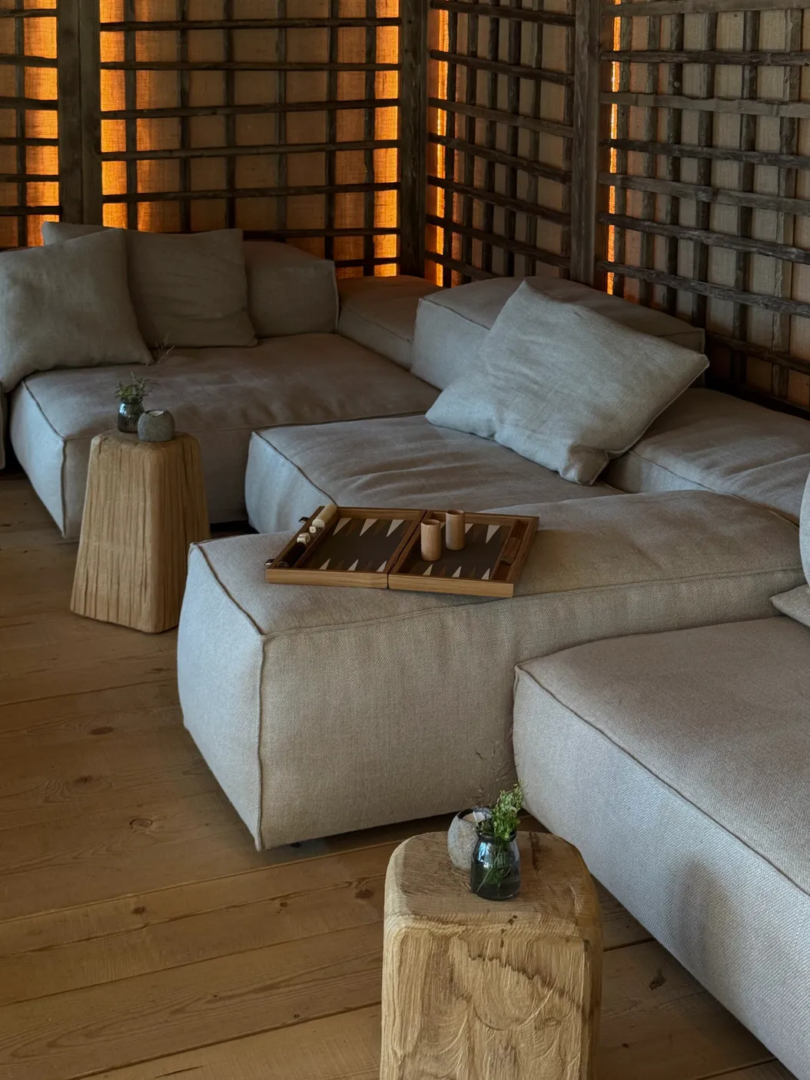
Between Tyrol and Bavaria: a cultural borderland of alpine heritage and mountain life
Geographically, Eriro lies close to the line dividing Tyrol from Bavaria. Culturally, the area reads less like a border and more like a gradient. Dialects slip across valleys. Cooking techniques nod back and forth. Festive customs borrow from both sides. The mountains act as corridors of exchange, linking communities rather than sealing them off.
Eriro’s kitchen reflects this gentle hybrid. Methods of preserving meat and vegetables draw strongly from Tyrolean practice. Herb use links into a wider alpine vocabulary that runs from France to Slovenia. Dairy work – the cheeses, butters and fresh curds that appear at breakfast and dinner – feels distinctly central European, with flavors that many would associate with Bavarian farmsteads.
Rituals such as the Bergfeuer extend this cross-border cooperation. Groups organizing the fires often include residents from both sides of the line, united by ridgeline rather than passport. Carnival masks draw from Germanic and alpine storytelling at the same time, and the craftsmen who carve them often have clients and students across the region.
On a more practical level, Eriro offers a usable example for anyone working on mountain hospitality projects in Europe and beyond. It shows how architecture can arise directly from snow loads, available species and existing structures; how energy and water systems can be kept tight and local; how tourism can respect and even strengthen agricultural and cultural patterns instead of erasing them.
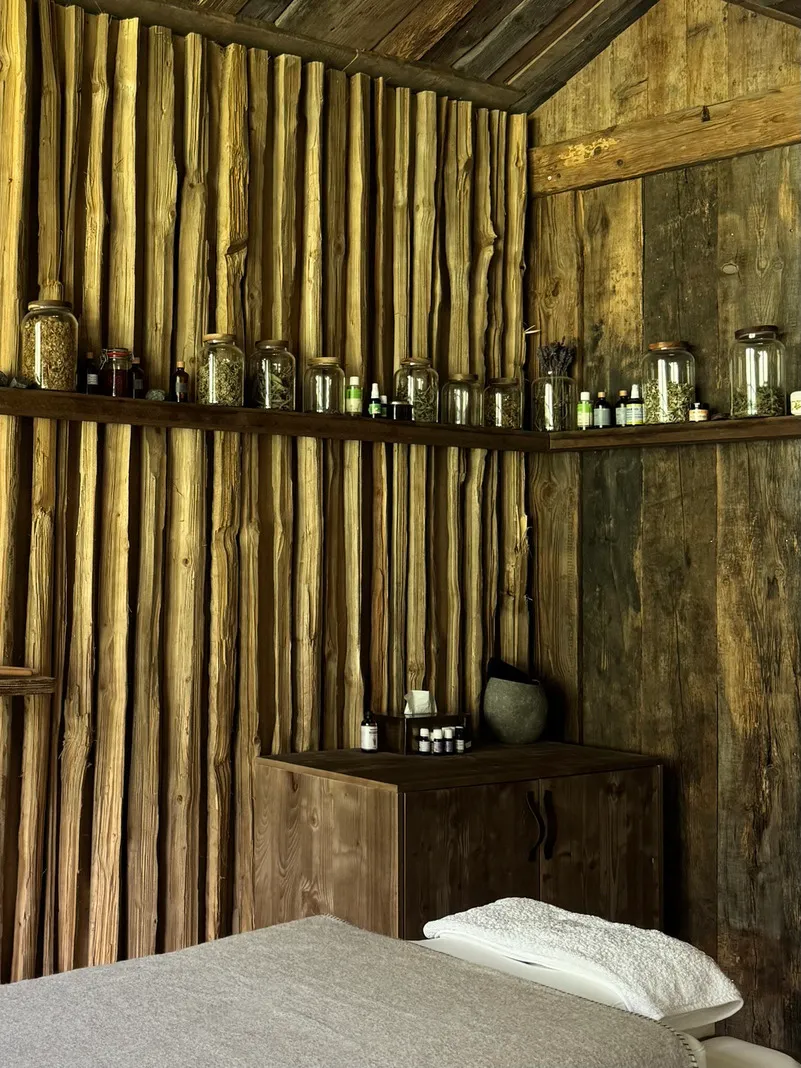
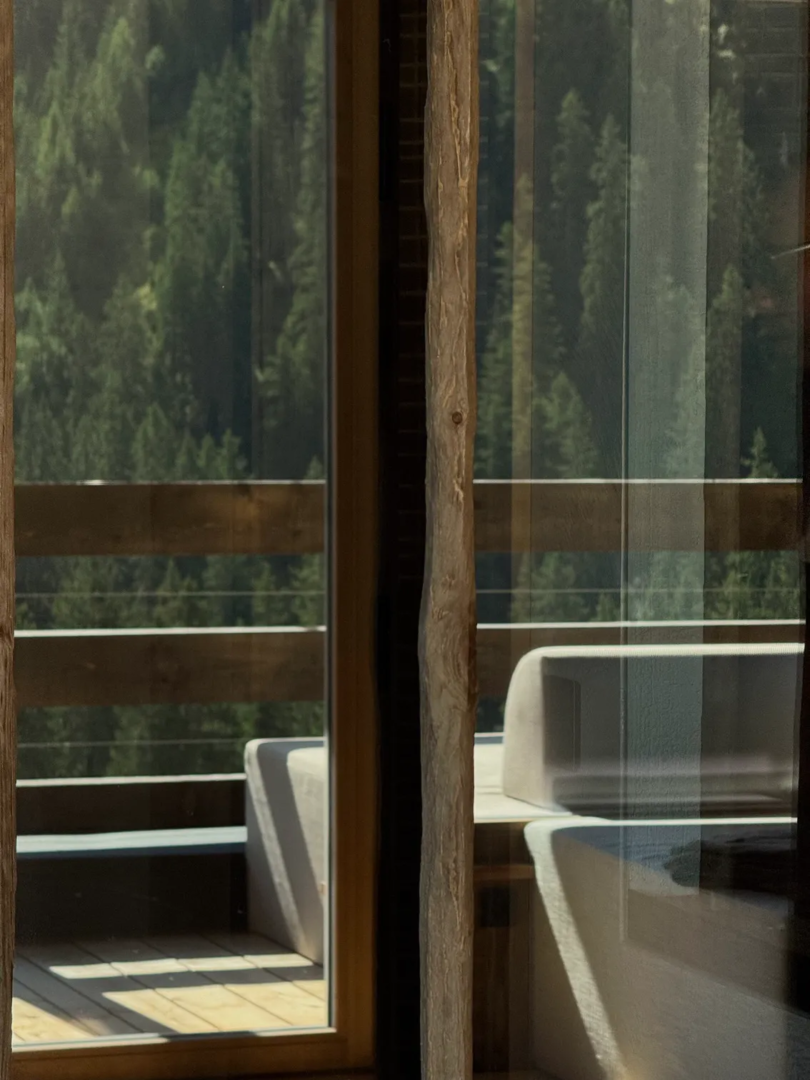
A wool-sock welcome: Eriro as a blueprint for slow, eco-conscious mountain hospitality
For all the attention to systems and traditions, the spirit of Eriro can be captured in a small, almost domestic moment: the pair of wool socks waiting in the suite when a guest opens the door. They invite slow walking on wooden floors, evenings spent reading by a window, the feeling of being grounded in a place that asks for a gentler rhythm.
Around that modest gesture, a larger structure comes into focus. Architecture follows the slope and the snow. Water arrives from a spring just above the roofs. Heat comes from trees that also built the walls. Meals trace a short route from farm and forest to plate. Festivals and legends continue on their own terms, with or without visitors.
For the contemporary “conscious traveler,” the appeal lies exactly in this coherence. Eriro does not promise escape from the world; it offers a closer relationship with a particular corner of it, observed carefully and inhabited with care. The mountain keeps its own calendar. The retreat simply gives you a front-row seat – and a pair of socks – to experience it.

